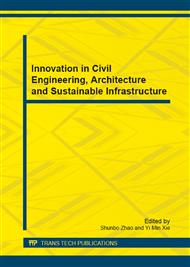p.227
p.231
p.236
p.240
p.244
p.248
p.252
p.256
p.260
Research on Regional Dividing Technology for Liquefaction-Induced Lateral Spreads Based on MAPGIS
Abstract:
A simplified empirical statistical regression method for liquefaction-induced lateral spreads is stated in this paper. It is used to determine the corresponding calculation parameters for Tangshan city and its south region where 36 borehole data were collected. Using two multiple linear regression formulas, the free face model and the ground slope model are developed to calculate the lateral spread at each filed survey point in the region. The liquefaction-induced lateral spreads map was divided into hazard zones according to the calculated horizontal displacement at each borehole based on MAPGIS.
Info:
Periodical:
Pages:
244-247
Citation:
Online since:
November 2012
Authors:
Price:
Сopyright:
© 2012 Trans Tech Publications Ltd. All Rights Reserved
Share:
Citation:


